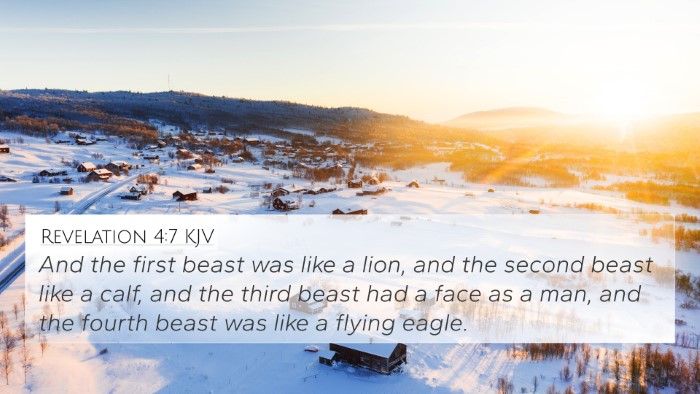Bible Verse Meaning of Revelation 6:3
Revelation 6:3: "And when he had opened the second seal, I heard the second beast say, Come and see." This verse ushers in the second seal of the prophetic vision given to John, revealing profound insights into the unfolding narrative of the end times and the judgments of God.
Understanding the Context
This verse occurs within the apocalyptic visions depicted in the Book of Revelation, specifically within the context of the seals. Each seal represents a significant event or judgment. The opening of the seals by the Lamb signifies the orchestrated unfolding of God’s plan towards humanity.
Interpretative Insights from Public Domain Commentaries
Matthew Henry's Commentary
Matthew Henry emphasizes the symbolism associated with the seals, pointing out that the second seal depicts the spirit of warfare that arises upon the earth. He draws connections to prophecies found in other scriptures, noting the rising violence and conflict as signs of the last days. This verse invites reflection on the tribulations linked to human conflict, echoing themes seen in Matthew 24:6-7 and James 4:1-2 concerning wars and strife.
Albert Barnes' Notes
Albert Barnes suggests that the second seal introduces the concept of conquest and bloodshed through the description of a rider on a red horse, symbolizing war. He connects this imagery with past biblical references such as Zechariah 1:8, where horses are utilized as instruments of divine judgment. Barnes highlights the significance of the phrase "Come and see," which invites the reader into the revelation of the seal's meaning.
Adam Clarke's Commentary
Adam Clarke provides an exegetical approach to understanding the visionary language, proposing that this seal foretells the tribulations endured by the church. He emphasizes the importance of discerning these prophecies and aligning them with Old Testament themes of judgment and divine intervention, particularly referencing Isaiah 19:2 as a thematic parallel concerning conflict among nations.
Thematic Connections
This verse has significant thematic connections within the wider biblical narrative, particularly regarding divine judgment and human response. By examining these connections, one can discern how Revelation 6:3 reflects the overarching themes of conflict, justice, and the ultimate sovereignty of God.
Relevant Cross-References
- Matthew 24:6-7 - Speaking about wars and rumors of wars.
- James 4:1-2 - Discussing the source of conflicts and wars among people.
- Zechariah 1:8 - Mentioning horses in the context of God's judgment.
- Isaiah 19:2 - Foretelling difficulties among nations.
- Revelation 6:4 - Continuation of themes of conflict and suffering.
- Revelation 19:11 - Christ as the righteous judge in warfare.
- Matthew 10:34 - Jesus speaking about division coming from his message.
Applying the Meaning of Revelation 6:3
For those seeking to understand the depth of Revelation 6:3, consider how these verses highlight the human condition during times of turmoil. The implications of this verse can serve to strengthen one’s faith as one recognizes that amidst conflict, God's sovereign plan continues to unfold.
Tools for Bible Cross-Referencing
Utilizing cross-referencing tools such as a Bible concordance or a cross-reference Bible study guide can enhance your understanding. Engaging in cross-referencing Bible study methods allows for a richer exploration of themes and connections, enabling believers to gain profound insights into God’s word.
Conclusion
In summary, Revelation 6:3 serves as an essential verse within the apocalyptic framework of the book. By using various Bible reference resources, one can uncover rich inter-Biblical dialogues that enhance the understanding of this prophecy. Thus, further exploration into associated passages will provide a broader context, illustrating how scripture continually speaks to the present day.




